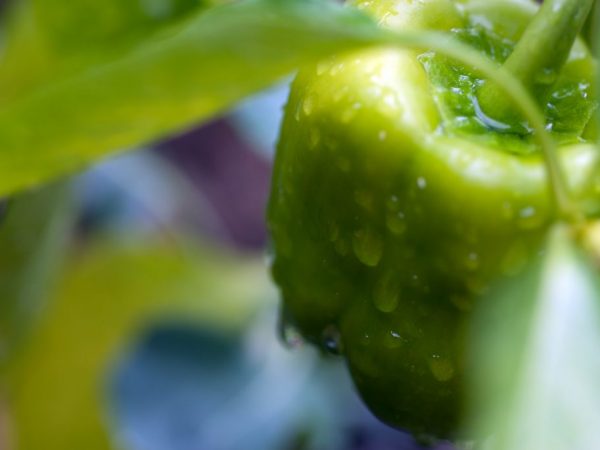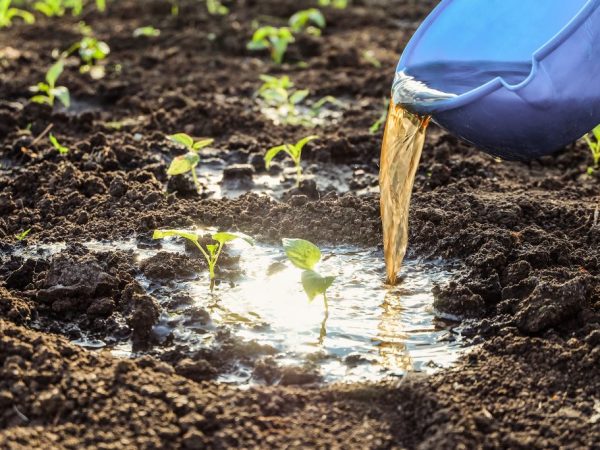Top dressing of bell peppers
To obtain a good harvest, you need not only timely watering and weeding, but high-quality feeding of bell peppers. Lack of nutrients impairs the growth of bushes, slows down the formation and development of ovaries.

Top dressing of bell peppers
In order to get a good harvest, they begin to prepare the site in the fall. The best fertilizer for planting bell peppers is cow or horse manure, as well as bird droppings.
Organic matter is introduced into the ground during the autumn digging of the site. Manure consumption per 1m is approximately 2-3 kg. This amount is enough to provide the plant with all the necessary substances for the first time.
Also, the introduction of manure into the soil, makes it looser and softer. All thanks to the vital activity of earthworms. During the winter, manure rots and in the spring the soil is ready for planting.
The only drawback of such fertilization is the high probability of the introduction of pests and their eggs on the site. So the bear (or cabbage) is a serious enemy of pepper seedlings and other vegetable crops. It is quite difficult to get her out of the site.
Top dressing of seedlings
It is important to organize proper care of the pepper from the very first days of its growth.
- For planting, it is recommended to choose not a simple soil from a summer cottage, but a special substrate for seedlings. It is already rich in nutrients that will contribute to the normal development of plants in the early days.
- When 3 true leaves have already appeared on the seedlings, you need to feed the bell pepper with nitrogen-containing fertilizers. Such feeding enhances the growth of aerial parts, which in turn improves the process of photosynthesis and starch accumulation.
Top dressing of seedlings with folk remedies
As a prophylaxis for various diseases and to stimulate crop growth, it is also recommended to feed bell peppers with such a mixture:
- milk whey 0.5 l;
- iodine 3 - 4 drops;
- hydrogen peroxide 1 tsp
All components are mixed immediately before use. The liquid is vigorously shaken and sprayed onto the leaves and stems of the pepper using a spray bottle. Such foliar feeding also helps to fight small pests such as aphids, spider mites, thrips.
Top dressing when transplanting
It is necessary to feed the bell pepper during transplantation to permanent beds. Regardless of whether the bushes will grow in open ground or in a greenhouse, the introduction of mineral fertilizers is mandatory.
Put 2 tbsp in each hole. l. wood ash and mix well with the soil. This is enough for the plant to take root, to grow.
In 2 weeks

For the first feeding, prepare the infusion
It is recommended to fertilize the pepper for the first time after planting in the ground no earlier than 2 weeks later.
During this time, the roots damaged during transplantation are restored, thereby establishing root nutrition. The seedlings are already able to absorb nutrients from the soil normally.
Immediately after planting the seedlings, they begin to prepare the infusion for feeding. For full readiness, he needs to wander for at least 10 - 14 days. Prepare it from:
- mullein;
- bird droppings;
- water;
- onion peel.
All components are mixed in a container. From time to time, the fertilizer needs to be stirred or shaken. Pour the liquid to the very root, trying not to get on the leaves and stems. Pre-dressing is diluted 1:10 with water.
Top dressing during flowering and ovary formation
It is necessary to fertilize the bushes a second time at the first signs of flower formation and flowering. At this stage, the young plant needs potassium and phosphorus. Superphosphate and potassium sulfate are ideal. You will need to dilute 30 g of each fertilizer into 1 bucket. This amount is enough for feeding 7-10 bushes.
For the formation of the ovary, the pepper needs a balance of mineral and organic fertilizers. To do this, you need to follow the instructions for using the dressing.
As an organic matter, a herbal infusion is introduced into the soil:
- The weed grass is cut finely and placed in a deep container. For this purpose, you can use plastic flasks of 5 - 7 liters. Plants should be selected without mature testes. Otherwise, the seeds will sprout quickly in the beds.
- Live yeast is diluted in warm water. They are taken at the rate of 100 g per 5 liters of water. It is also recommended to add 2 tbsp to this mixture. l. sugar for the accelerated development of yeast colonies.
- The solution is poured over the grass and left in the sun for 10 days. After fermentation stops, the infusion is diluted with water in a ratio of 1:10. They are watered with 2 liters of plants under each bush.
Features of feeding in greenhouses
Unlike open ground, the crop bears fruit better in greenhouses. This is especially true for the northern regions, where the summer is not very warm.
Top dressing for a vegetable grown in greenhouse conditions is not so much different. Due to the lack of a natural cycle of organic matter, the concentration of certain substances in the greenhouse decreases. Plants need organic components more than mineral ones.
To compensate for this deficiency, they practice the introduction of food waste into the beds. For this, cuttings of vegetables and fruits, eggshells, tea leaves, coffee grounds, etc. are suitable. All this is buried in the ground in the fall and over the winter turns into a breeding ground for plants.
Conclusion
Growing pepper requires timely feeding. Observing all the requirements of agricultural technology of this culture, you can achieve good results even on scarce soils. An oversupply of fertilizer can cause a lack of harvest or a stop in growth of the bush. In addition, substances can accumulate in fruits.


